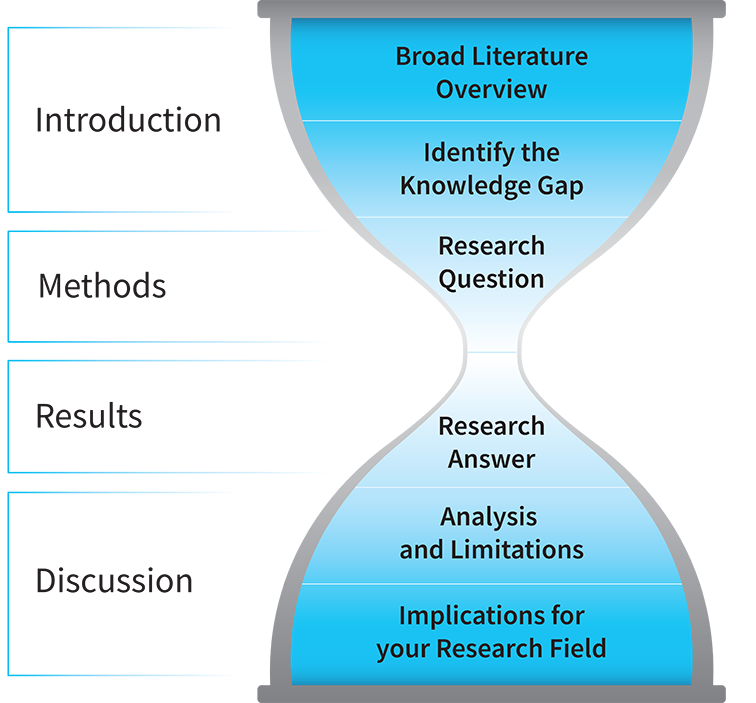科学写作的简单技巧
“发表还是毁灭”这句话在科学界广为人知。发表期刊文章是研究的重要组成部分,但通常没人教如何撰写文章。写一篇科研论文并不像听起来那么吓人。为了帮助您克服这部分空白和发表您的研究,这里有一些关于如何撰写和发表科学论文的技巧。
在本文中,我们将介绍:
- 从哪开始
- 保持生产力
- 常见错误

从哪开始
为了避免重写,并通过有效的写作来最大化您的时间和注意力。我们建议您选择相关的期刊,熟悉文章结构和长度,以不同于阅读的顺序来写文章的各个章节。
选择期刊
在您写下第一个字之前了解您的读者可以节省很多麻烦。哪些期刊发表过您所在领域的其他论文?选择一些发表过与您的发现具有相似影响的文章。了解每个期刊的发表流程。检查他们网站上的“潜在作者”部分,并检查长度、格式和语言要求。
结构
科学文章的结构旨在引导读者看完您的研究。IMRaD 结构决定了您写什么,而沙漏结构则详细说明了你写的深度和特异性。
IMRaD 指:前言、方法、结果和讨论。这种结构被普遍使用—尤其是科学和医学作者。IMRaD 提出了四个问题:您为什么开始,您做了什么,您发现了什么,这意味着什么?通过回答这些问题,您的文章将交流您研究的基本原理,并让您所在领域的其他人容易重复。

沙漏结构或知识漏斗决定了每个章节的详细程度。在确定您打算解决的知识空白之前,先进行文献综述和有关该主题的宽泛问题。缩小到您研究的具体问题、方法和结果。最后,讨论您的发现及其对该领域的影响。
长度
您的文章应该多长?答案是“文长要足够交流必要的信息,不要太长反而失去清晰度”。幸运的是,科学写作背后的科学已经确定了已发表文章的每个部分的平均长度 (1, 2).
- 摘要:1段,250字,一般无参考文献。
- 前言:3段,400 字(但是有些期刊可能将其限制在 <350),以及 5-10 篇参考文献。
- 方法:10段,750 字,以及5-15 篇参考文献。
- 结果:9段,1000 字,一般无参考文献。
- 讨论:8段,1500 字,以及 10-20 篇参考文献(其中一些可能在前文出现过)。
大多数现代文章都使用补充材料部分来确保在正文中只显示关键信息。
不要按顺序写
令人惊讶的是,按阅读顺序撰写论文并不是最简单的方法。相反,先写您知道的第一手资料,然后回顾文献和支持研究。来自 Elsevier 、SPIE 和 Nature 的成功作者们建议按以下顺序处理:
1. 主要陈述
确定您的主要陈述或愿景陈述,意味着将您的研究浓缩为您文章的主要信息。写的时候记住您的主要陈述,并确保每个部分都讲述了支持它所必需的故事的一部分。
2. 图表
这些是您文章的主要吸引力。您是否以正确的方式显示数据?您将如何表示对照或统计学意义?图比大段文字更能吸引眼球。先把这些做好,然后文章的其余部分应该围绕它们形成。
3. 方法、结果和讨论
从您的方法开始,自然导向您的结果和讨论。在链接回您研究提出的原先问题之前,先涵盖您的样本数、步骤、分析和结果。通过评估您研究的局限性以及您的结果与当前文献的关系来结束您的讨论。
4. 结论
您讨论的最后一段应该总结您研究的意义,并强调您文章的主要陈述。
5. 前言
在讨论之后再写前言,可以确保理解研究所需的所有信息都在。在完成研究的过程中,您应该对相关的文献有全面的了解。回顾您主题相关的文献,为您的读者找出知识空白。您的研究如何填补这一空白?
6. 摘要和标题
保持您的摘要和标题简短且内容丰富。最后写这些会使它们更准确,因为您的文章故事可能会在撰写时发生变化。
7. 参考文献和关键词

Writing productively
Staying on task is the bane of writers everywhere - even outside of science.
When and where
Organizing a dedicated time and space to write will help you focus on your writing. Setting up a routine can keep you in the zone for longer periods. Find out if your organization has regular writing groups, or start one! Not only do they improve science writing productivity, but they also provide a great sense of support for science writers (3).
Make it easy for yourself
Everyone gets distracted. Turn off your notifications for email and social media. Mute your phone, block out your calendar and let your colleagues know that this is your focus time. Removing distractions and preventing yourself from multi-tasking can be one of the most impactful habits for improving your productivity. When you think of something you want to do - that isn’t writing your paper! - keep a notebook handy to jot it down for later. These activities can be rewards for productive writing sessions.
Set realistic goals for each writing session. Start with small chunks of writing. If you’ve already planned what you will write before you sit down to do it, you are more likely to achieve that goal.
There is no ‘one right way’
Whether you like to plan out every point in advance or just write as much as you can in one sitting, ignoring spelling and style for editing later, there is no one right way to write. Find the way to get words on the screen which works best for you.

Common mistakes
Here are some common mistakes first-time authors make when writing a scientific paper.
Correct English
Unfortunately, the scientific community is biased toward papers published in English (4). English papers have more citations than their non-English counterparts, which might be due to the reach of English journals. Before submitting your article for review, ensure your English is correct. Recruit your colleagues to proofread your paper. A fresh set of eyes might see something you’ve missed.
Correct language is about more than just using the right words. It also encompasses syntax, readability, and style. This includes keeping sentences simple, avoiding passive voice, and dropping descriptive language in favor of repeating empirical terms. These elements can weaken otherwise excellent science - don’t let them undermine yours! If in doubt, some journals offer an English correction service before publication, which can help bring your writing up to publication standards.
Editing and formatting
While you can leave the editing until last - don’t let looking up exact details slow you down if you are on a roll - it should never be forgotten. If you have multiple co-authors or proofreaders, track changes made to the first draft using the tracking feature in software like Microsoft Word or Google Docs. This way, you won’t lose any detail between edits or struggle with version control.
Formatting is an art. Don’t forget that the first audience you are writing for is the journal editor, and a good layout can prevent early rejection. Once you’ve got everything on paper, it is important to check your article for correctness and consistency. Double-check the formatting guides for the journals you wish to submit to - some journals may have specific requirements around abbreviations, for example.
As a general rule, write your paper in double-spaced 12-point font, with page margins of 3 cm. You may also want to number your pages and rows of text for ease of editing by your journal reviewer. Ensure that your text, figures, and captions are consistent and your references haven’t changed between drafts.
Ethics
Referencing is foundational to research. All scientific papers build on the work of others; however, you must be sure to cite your references correctly to avoid plagiarism.
Publish and prosper
Your research is not finished until it’s communicated. Don’t be paralyzed by a blank page - get your research published.
Connecting with clinicians: Tips for translating your research to clinical practice »
10 simple things you can do to improve your human autonomic studies »
Helpful Resources
- Araújo, Claudio Gil Soares de. “Detailing the Writing of Scientific Manuscripts: 25–30 Paragraphs.” Arquivos Brasileiros de Cardiologia, 2014. Crossref, https://doi.org/10.5935/abc.20140019.
- Heßler, Nicole, et al. “Empirical Analysis of the Text Structure of Original Research Articles in Medical Journals.” PLOS ONE, edited by Omid Beiki, vol. 15, no. 10, 2020, p. e0240288. Crossref, https://doi.org/10.1371/journal.pone.0240288.
- Kwan, Patchareeya P., et al. “Faculty Writing Groups: The Impact of Protected Writing Time and Group Support.” International Journal of Educational Research Open, vol. 2, 2021, p. 100100. Crossref, https://doi.org/10.1016/j.ijedro.2021.100100.
- Bitetti, Mario S. di, and Julián A. Ferreras. “Publish (in English) or Perish: The Effect on Citation Rate of Using Languages Other than English in Scientific Publications.” Ambio, vol. 46, no. 1, 2016, pp. 121–27. Crossref, https://doi.org/10.1007/s13280-016-0820-7.

